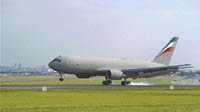Boeing has brought the first of four KC-767A tanker/transports for the Italian air force to the show, while it has just delivered its first 'green' 767 in-flight refuelling tanker to its Wichita, Kansas, site. These orders, however, are just 'hors d'oeuvres' compared to the 'main course' of the planned USAF order to regenerate its in-flight refuelling fleet.
The US Air Force is expected to issue requests for proposals this summer for a fleet of aircraft. This follows the release of an analysis of alternatives mandated by the US Congress after last year's collapse of the air force's planned acquisition of 100 Boeing KC-767s.
"We're continuing to work on getting a proposal together," says George Muellner, vice president - general manager, Air Force Systems, of Boeing Integrated Defense Systems. Muellner makes it clear that the company's efforts are still focused on the 767, despite recent comments that had been interpreted as suggesting that the company would look at a development of the new 787 for the tanker role. "We're looking at the 767, not 787."
In addition, two US studies on the future shape of the country's armed forces will determine the future of the C-17 transport aircraft. Boeing has made it clear that it needs new orders for the type in the 2006 defence budget, if a gap in production is to be avoided after the current order for 180 C-17s is completed in 2008.
"We need something, not necessarily a new multi-year deal," says Muellner. "All the announcements over the past several years have been that they thought they needed at least 222 of the aircraft. It's a question of how do they fit them into the budget."
The only export customer for the very capable but expensive C-17 so far has been the UK Royal Air Force, which plans to purchase the four aircraft it has on lease and buy a fifth. Muellner believes there are "realistic" chances of the aircraft finding further overseas sales.

Boeing has had "three or four" nations ask for information and "rough order of magnitude pricing" for the aircraft. "I think several of them are realistic; they have defined airlift requirements that they need to fill. It's just an issue of when they could fit it into their budget."
On the fighter front, meanwhile, Boeing is also awaiting an imminent decision this time by Singapore - on whether the F-15 or Dassault's Rafale will win the contest for the island nation's new fighter contract.
In the longer run, the F-15 has strong prospects of further sales to South Korea, which has earmarked about $5 billion from 2009 for a new fighter purchase. Boeing is already supplying Seoul with 40 F-15Ks. That programme has been "moving along very wellall the indications are the Koreans are very happy," says Muellner. "So I would hope the F-15 would be a hot commodity for that [new batch]."
The long-running argument between the US and Europe over alleged subsidies to Boeing and Airbus threatens to impinge on several military contracts following last month's attempt by a US Congressman to block European companies from US defence contracts.
Source: Flight Daily News























